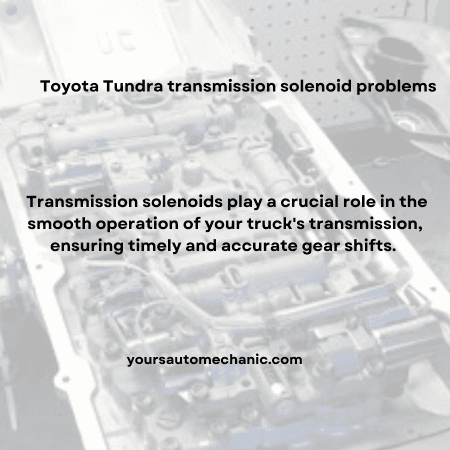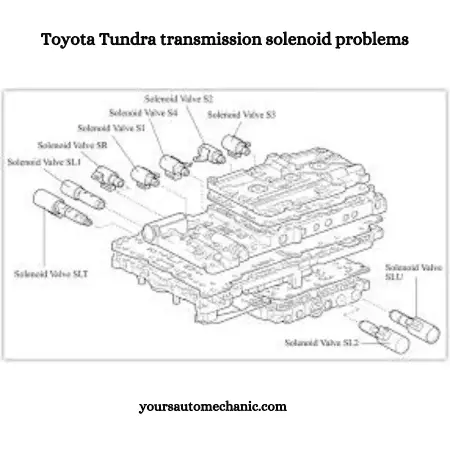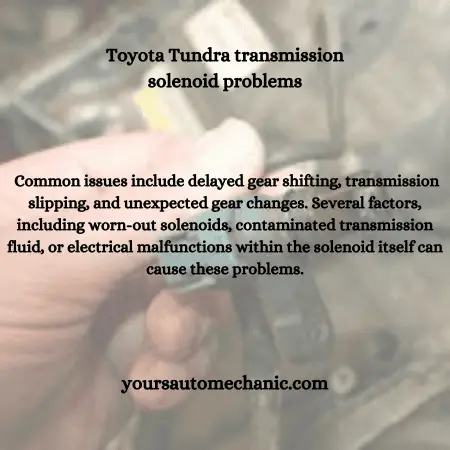The Toyota Tundra is a popular full-size pickup truck known for its durability and performance. However, like all vehicles, it can experience issues over time. One common problem that Tundra owners might face is with the transmission solenoid. This article will provide a detailed look into the problems associated with the transmission solenoid in Toyota Tundras, including symptoms, causes, and solutions.
What is a Transmission Solenoid?
A transmission solenoid is an electromechanical component that controls the flow of transmission fluid within an automatic transmission. It is responsible for regulating the gear shifts by opening and closing valves that control the fluid’s pressure. There are different types of transmission solenoids, including shift solenoids, lock-up solenoids, and pressure control solenoids, each serving a unique function within the transmission system.
Must Read: Braking Power Low Toyota – Causes & Solutions

Toyota Tundra Transmission Solenoid Problems
1- Stuck Solenoid
One significant issue is a stuck solenoid. The solenoid is responsible for controlling the flow of transmission fluid, which is crucial for shifting gears. When the solenoid gets stuck, it can cause the transmission to either shift improperly or not shift at all. This problem usually arises from internal mechanical failure or debris that gets lodged in the solenoid, preventing it from moving as it should.
2- Electrical Issues
Electrical issues can also affect the solenoid’s performance. The solenoid depends on electrical signals to operate correctly. If there are problems with the wiring, such as frayed wires or loose connections, these signals can be disrupted. Faulty connectors can also lead to solenoid malfunction. When the electrical signals are compromised, the solenoid cannot function properly, which can result in shifting problems.
3- Dirty or Clogged Solenoid
Another common issue is a dirty or clogged solenoid. Transmission fluid needs to pass through the solenoid to help control gear shifting. However, if the fluid is contaminated with dirt and debris, it can clog the solenoid. This blockage can make it difficult for the fluid to flow through the solenoid, leading to erratic transmission behavior or a failure to shift gears properly.
4- Wear and Tear
Over time, wear and tear can affect the solenoid’s performance. Solenoids are mechanical parts that experience constant use, and this can cause them to degrade. As they wear out, they lose their ability to regulate transmission fluid effectively. This degradation can lead to various transmission issues, including difficulties in shifting gears.
5- Fluid Problems
Finally, problems with the transmission fluid itself can impact the solenoid’s operation. The solenoid relies on clean and sufficient transmission fluid to function correctly. If the fluid is low or dirty, it can reduce the efficiency of the solenoid. This can result in shifting problems, as the solenoid cannot operate at its full capacity without proper fluid conditions.

Causes of Transmission Solenoid Problems
Transmission solenoid problems in the Toyota Tundra can be caused by various factors. Understanding these causes can help in diagnosing and addressing the issues effectively.
Mechanical Failure
One of the primary causes of transmission solenoid problems is mechanical failure. The solenoid is a mechanical component, and over time, parts within it can wear out or break. This wear and tear can prevent the solenoid from moving correctly, leading to shifting issues.
Electrical Issues
Electrical issues are another common cause of solenoid problems. The solenoid relies on electrical signals to operate. If there are problems with the wiring, such as frayed wires, loose connections, or damaged connectors, these signals can be disrupted. When the electrical signals are compromised, the solenoid cannot function properly, resulting in transmission problems.
Contamination and Clogging
Contamination and clogging are significant causes of solenoid problems. Transmission fluid can carry dirt, debris, and other contaminants. Over time, these particles can accumulate and clog the solenoid. A clogged solenoid cannot allow transmission fluid to flow through it properly, leading to erratic transmission behavior and shifting issues.
Wear and Tear
Wear and tear over time can also lead to solenoid problems. Solenoids are subjected to constant use, and as they age, their components can degrade. This degradation can affect the solenoid’s ability to regulate transmission fluid effectively, causing various transmission issues.
Fluid Quality and Level
The quality and level of transmission fluid play a crucial role in solenoid performance. Low or dirty transmission fluid can impact the solenoid’s efficiency. Insufficient fluid levels can cause the solenoid to overheat or operate improperly, while dirty fluid can introduce contaminants that clog the solenoid. Both scenarios can lead to transmission problems.
Debris and Foreign Objects
Debris and foreign objects can also cause solenoid problems. Small particles or objects that find their way into the transmission system can block or damage the solenoid. Regular maintenance and proper sealing of the transmission system can help prevent such issues.

Symptoms of a Failing Transmission Solenoid
A failing transmission solenoid in the Toyota Tundra can exhibit various symptoms. Recognizing these signs early can help prevent further damage to the transmission system.
Erratic Shifting
One of the most common symptoms of a failing solenoid is erratic shifting. The transmission may shift gears unpredictably, causing the vehicle to lurch or jerk. This can happen when the solenoid is unable to properly control the flow of transmission fluid.
Stuck in Gear
A faulty solenoid can cause the transmission to get stuck in a particular gear. This means the vehicle may not shift up or down, making it difficult to accelerate or decelerate properly. Being stuck in gear can significantly affect the drivability of the vehicle.
Delayed Shifting
Delayed shifting is another symptom of a failing solenoid. The transmission may take longer than usual to shift from one gear to another. This delay can be noticeable, especially when accelerating from a stop or when trying to shift into higher gears.
Transmission Slipping
Transmission slipping occurs when the vehicle unexpectedly shifts out of gear. This can happen if the solenoid fails to maintain the correct pressure within the transmission. Slipping can cause a sudden loss of power and can be dangerous if it happens while driving.
Check Engine Light
A failing transmission solenoid can trigger the check engine light on the dashboard. The vehicle’s onboard diagnostic system can detect issues with the transmission solenoid and illuminate the check engine light to alert the driver. A diagnostic scan can provide specific error codes related to the solenoid.
No Shifting
In severe cases, a failing solenoid can prevent the transmission from shifting gears at all. This can leave the vehicle stuck in neutral or in one gear, rendering it undrivable. Immediate attention and repair are required in such cases.
Unusual Noises
Unusual noises, such as whining or humming, can indicate solenoid problems. These noises may occur when the transmission tries to shift gears but fails due to solenoid malfunction. Listening to these sounds can help in the early detection of solenoid issues.
How to Fix Transmission Solenoid Problems
Fixing transmission solenoid problems in a Toyota Tundra involves several steps, from diagnosing the issue to performing the necessary repairs or replacements. Here’s a detailed guide on how to address these problems:
1- Diagnosis
Start by checking if the check engine light is on. Use an OBD-II scanner to retrieve diagnostic trouble codes (DTCs) that can help pinpoint solenoid issues.
Perform a test drive to observe any symptoms like erratic shifting, delayed shifting, or transmission slipping.
Check the transmission fluid level and condition. Low or dirty fluid can affect solenoid performance. If the fluid is dirty, it may need to be replaced.
2- Visual Inspection
Look for any damaged, frayed, or loose wiring and connectors leading to the solenoid. Repair or replace any faulty components.
Inspect the transmission system for any debris or foreign objects that might be clogging the solenoid.
3- Repair and Replacement
If the transmission fluid is low or dirty, perform a complete transmission fluid change. Ensure you use the correct type of fluid recommended for the Toyota Tundra.
In some cases, cleaning the solenoid can restore its functionality. Remove the solenoid and clean it thoroughly to remove any debris or buildup.
If cleaning does not resolve the issue, the solenoid may need to be replaced. This involves:
- Locating the Solenoid: Refer to the vehicle’s service manual to locate the specific solenoid that needs replacement.
- Removing the Solenoid: Disconnect the battery, remove the transmission pan, and locate the faulty solenoid. Carefully disconnect and remove it.
- Installing the New Solenoid: Install the new solenoid, reconnect the wiring, and reassemble the transmission pan. Refill the transmission with the appropriate fluid.
If you are unsure about diagnosing or fixing the problem, consult a professional mechanic. They have the tools and expertise to accurately diagnose and repair transmission solenoid issues.
Sometimes, a more extensive transmission service may be required, including flushing the transmission system and replacing multiple solenoids.
Cost of Fixing Transmission Solenoid Problems
The total cost of fixing transmission solenoid problems can range widely based on the specifics of the repair:
- Simple Fluid Change and Cleaning: If only a fluid change and solenoid cleaning are needed, the total cost may be between $100 and $200.
- Solenoid Replacement: For a single solenoid replacement, the total cost, including parts and labor, can range from $200 to $500.
- Complete Solenoid Pack Replacement: If a complete solenoid pack needs to be replaced, the total cost can be between $400 and $1,000, depending on parts and labor rates.
The cost of fixing transmission solenoid problems in a Toyota Tundra can range from around $100 for simple fixes to over $1,000 for more complex repairs involving multiple solenoids and professional labor. Regular maintenance and early diagnosis can help minimize these costs.
Further Readings
- Drive Start Control Malfunction – Signs & Causes
- Why My Car Won’t Accelerate But RPMs Go Up? Explained
- Why Won’t My Car Take Freon? 5 Main Reasons
- What Happens If My Drive Shaft Breaks While Driving?
Conclusion
Transmission solenoid problems in the Toyota Tundra can be a hassle, but understanding the causes, symptoms, and solutions can help you address them effectively. Regular maintenance and early diagnosis are key to keeping your Tundra running smoothly and efficiently. If you encounter any transmission issues, don’t hesitate to seek professional help to ensure your vehicle remains in top condition.
